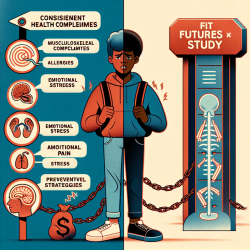Introduction
Exertional Heat Stroke (EHS) is a critical condition that poses a significant risk to athletes and military personnel. Effective and timely intervention is crucial to prevent severe medical complications or fatalities. A recent systematic review titled "Exertional Heat Stroke, Modality Cooling Rate, and Survival Outcomes: A Systematic Review" provides valuable insights into the impact of cooling modalities on survival outcomes. This blog aims to translate these findings into actionable strategies for practitioners to improve patient care and encourage further research in this area.
Understanding the Research
The systematic review analyzed 521 cases of EHS from sports and military settings, focusing on the cooling rate's influence on survival and medical complications. The study categorized cooling methods as "adequate" (>0.15 °C/min) or "insufficient" (<0.15 °C/min). The findings were compelling: none of the patients treated with adequate cooling methods succumbed to EHS, whereas 23 patients died when treated with insufficient cooling. Furthermore, the risk of medical complications was 4.57 times higher in patients who received insufficient cooling.
Key Takeaways for Practitioners
To enhance patient outcomes in EHS cases, practitioners should focus on the following strategies:
- Adopt Adequate Cooling Methods: Utilize cooling modalities that achieve a rate greater than 0.15 °C/min. Cold Water Immersion (CWI) is identified as the gold standard, effectively reducing body temperature and preventing complications.
- Rapid Recognition and Response: Early identification of EHS symptoms and immediate intervention are crucial. Practitioners should be trained to recognize signs of EHS and initiate cooling protocols promptly.
- Collaborative Efforts: Encourage collaboration between emergency departments, sports medicine, and military healthcare providers to establish and implement standardized cooling protocols.
- Innovative Solutions: In settings where CWI is not feasible, consider alternatives like tarp-assisted cooling methods, which have shown promising results in achieving adequate cooling rates.
Encouraging Further Research
While this systematic review provides a comprehensive analysis of cooling modalities, there is a need for continued research to explore innovative cooling techniques and their effectiveness in various settings. Practitioners are encouraged to contribute to the body of knowledge by conducting studies and sharing their findings.
Conclusion
The systematic review underscores the critical role of adequate cooling in enhancing survival outcomes for EHS patients. By implementing evidence-based cooling strategies and fostering collaborative efforts, practitioners can significantly improve patient care and outcomes. To explore the original research paper and delve deeper into the findings, please follow this link: Exertional Heat Stroke, Modality Cooling Rate, and Survival Outcomes: A Systematic Review.










